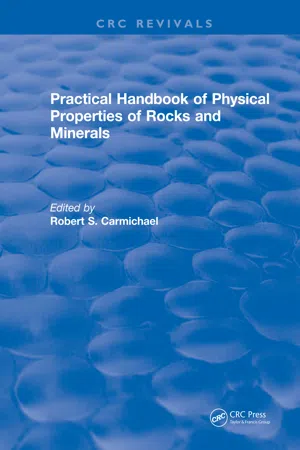
Practical Handbook of Physical Properties of Rocks and Minerals (1988)
- 756 pages
- English
- ePUB (mobile friendly)
- Available on iOS & Android
Practical Handbook of Physical Properties of Rocks and Minerals (1988)
About This Book
CRC Practical Handbooks are a series of single-volume bench manuals that feature a synthesis of the most frequently used, basic reference information. These highly abridged versions of existing CRC multi-volume Handbooks contain largely tabular and graphic data. They provide extensive coverage in a scientific discipline and enable quick, convenient access to the most practical reference information...on the spot! Leading professionals in their respective fields collaborated to provide individuals and institutions with an economical and easy-to-use source of classic reference information.The CRC Practical Handbook of PHYSICAL PROPERTIES of ROCKS and MINERALS, prepared by leaders in their specialties, has been constructed to serve as a convenient, compact, yet comprehensive source of basic information. The technical data have been compiled and selectively edited to provide an organized and definitive presentation of the physical properties of rocks and their constituent minerals. The format is primarily tabular and graphical, for easy reference and comparisons. There is also instructive textual material to present, explain, and clarify the data.
This edited and abridged version of the CRC Handbook of Physical Properties of Rocks, published in three volumes in 1982 - 1984, will serve as an easy-to-use source of current and useful reference information.
Frequently asked questions
Section VI
Seismic Velocities
Nikolas I. Christensen
INTRODUCTION
- The broad subdivision of the Earth into crust, mantle, and core
- The recognition of seismic discontinuities within the core and mantle that are probably related to phase changes
- The marked difference in overall structure of the oceanic and continental crust
| Bulk Modulus | |
| Shear Modulus | |
| Poisson’s Ratio | |
| Young’s Modulus | E = 2μ(1 + σ) |
| Compressional Wave Velocity | Vp = √[K + (4/3)μ]/ϱ |
| Shear Wave Velocity | Vs = √μ/ϱ |
Table of contents
- Cover Page
- Title Page
- Copyright
- Preface
- The Author
- Contributors
- Table of Contents
- SECTION I Mineral Composition of Rocks
- SECTION II Densities of Rocks and Minerals
- SECTION III Inelastic Properties of Rocks and Minerals: Strength and Rheology
- SECTION IV Magnetic Properties of Minerals and Rocks
- SECTION V Electrical Properties
- SECTION VI Seismic Velocities
- SECTION VII Seismic Attenuation
- SECTION VIII Radioactivity Properties of Minerals and Rocks
- SECTION IX Spectroscopic Properties of Rocks and Minerals
- SECTION X Engineering Properties of Rock
- Index